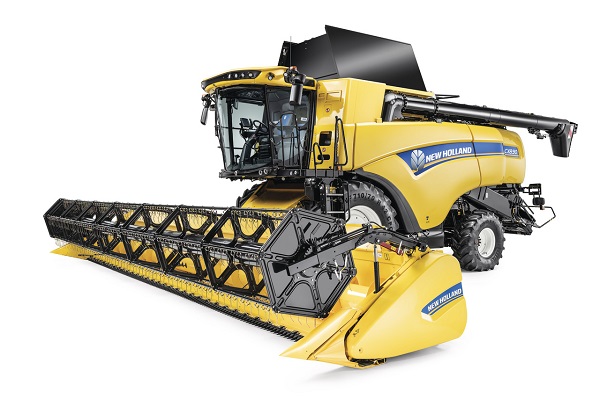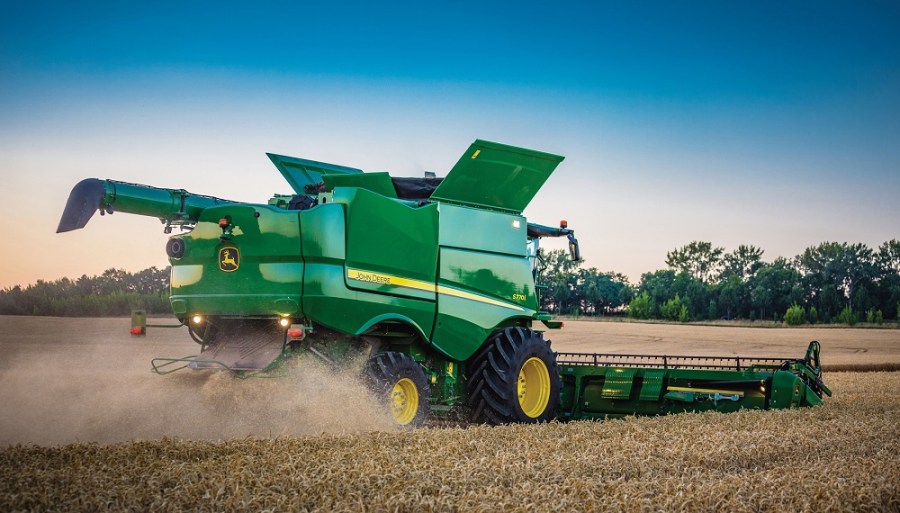With this year’s harvest heading into its final flight, it marks an apt time for growers to assess the performance of their current combine and consider whether they need to invest in something a bit newer ahead of next season. CPM takes an in-depth look at some of the latest additions to the market.
It’s all about pushing as hard as we can with our design to explore where its limits are.
By Charlotte Cunningham
There’s nothing quite like the low hum of a combine and watching from a distance as it munches its way through a crop on a late summer’s evening. But whatever your preferred machine livery, there’s no denying that growers are spoilt for choice when it comes to the technology on offer in a modern combine harvester.

The new CX.80 straw-walker combine has been specifically designed to boost throughput and lifespan.
John Deere
John Deere has recently announced a number of combine updates for the 2020 season, with the focus on increased throughput, automation and easier operation.
Among these is the The S-Series combine’s automatic regulation of forward speed, HarvestSmart, which has been optimised and integrated with the Interactive Combine Adjustment system ICA2. “In situations where ICA2 cannot achieve the required grain sample due to high levels of chaff or broken grain, or it exceeds the set loss rate, ICA2 automatically adjusts the HarvestSmart system and the combine’s speed just as the driver would normally do,” explains Edward Stephenson, harvesting division sales manager, John Deere. “At the same time, engine load is maintained at the desired level for maximum harvest efficiency.”
In terms of automation and grain handling, the firm is putting its money where its mouth is and is set to guarantee S700 Series customers a broken grain content of less than 1% in wheat for the 2020 harvest. If the proportion is higher, farmers will receive compensation for these losses equivalent to the price per tonne of lost grain.
With side winds having a huge effect on the distribution of combine residues, as of next year the S7000 series machines will also have the ability to automatically adjust spread angle using GPS to detect the direction of travel.
As connectivity becomes an increasingly important part of day-to-day farming, John Deere is keeping up with the trend by offering offering Wireless Data Transfer activation plus remote display access free of cost for five years. This enables data exchange between any mobile computers and smartphones as well as to the farm office via JDLink Connect.
Additionally, compatibility between the open platform MyJohnDeere.com website portal and other systems is being expanded, with data transfer in the ISO XML standard set to be available from 2020.
Next year is also set to see the launch of the new 700X variable length header, adds Edward. “This maintains the existing unit’s long 1200mm table for maximum harvesting capacity and minimum losses in oilseed rape, with the benefit of an even better crop flow.”
The latest development will feature a low-profile feeding design for smoother transition to the auger – particularly for short crops such as spring barley.
In addition, the slip clutch position has been moved directly to the auger to minimise wear, as well as 25% thicker skid plates on all units, he adds. “With increasing restrictions on the use of herbicides and crop desiccation products, the ability to effectively combine swaths of oilseed rape, legumes and other crops is regaining importance.”
Case IH
Building on its Axial-Flow range, Case IH has announced a number of modifications which are set to help boost precision and efficiency for growers.
One of the most significant changes is the launch of a new 8.5m Varicut header which has been designed specifically to cater for Controlled Traffic Farming. According to the manufacturer, the latest modification will use the frame of the existing 7.5m header – extended to 8.5m to save weight – with an actual cutting width of 8.5m, to ensure a true and repeatable 8m cut for an 8m controlled traffic system.
Available from next year, the new Axial-Flow combines will also feature a new LED light package, including row finder lights for safer harvesting at night.
The 7150 model is also set for a shake up and a power boost, moving from a rated boost power of 402hp to 413hp, with a peak power of 453hp compared to its current power of 442hp.
Fendt
Unveiled to the public for the first time at Agritechnica 2017, Fendt is set to extend its Ideal range with a new 790hp model which will be available to order from July 2020.
Among the Ideal 10’s new gizmos and gadgets, the latest addition to Fendt’s fleet features a new cleaning system and the Dual Helix separator, as seen on the Ideal 8 and 9. This combination increases throughput with the highest grain quality and lowest grain losses, increasing the area coverage of the new large combine.
Perhaps one of the most interesting features of the new design is the inclusion of IDEALDrive – a steering system without a steering wheel – making the Ideal 10 the first standard combine in Europe to be operated entirely without a steering wheel.
With Fendt IDEALDrive steering, the machine is controlled proportionately to the movement of a joystick on the left, with all the same functions on the joystick on the right armrest.
At the heart of Fendt’s latest edition is a new MAN 16.2 litre, Stage V engine, offering a maximum power of 790hp – up from 647hp as seen on the Ideal 9.
Like-for-like with the latest Claas Lexion – in terms of horsepower – it begs the question: Who will take the 2020 crown as the most powerful combine on the market?
Claas
More than two decades since its original launch, Claas has announced the introduction of the second-generation Lexion Hybrid combine which be available to growers as of next year.
While the essence of the original Lexion is still intact, about 66% of the parts that make up the new Lexion Aps Synflow Hybrid range are completely different.
Two versions of the new launch are available – the wide body Lexion 8000, which comprises three models and a further five models in the narrow body Lexion 7000 range.
The most significant of these models is probably the wide body 8900 which at 790hp looks to be the Bugatti Veyron of the arable world, after reportedly claiming the title as the most powerful combine on the market.
With a key focus on productivity, one of the most significant changes to the new-gen Lexion is a freshly designed threshing system.
Boasting a diameter of 755mm, the new threshing drum is an impressive 26% larger than the current 600mm drum found on the Lexion 780, and is fitted with 10 rasp bars, compared with eight. “These significant tweaks mean that the new-look Lexion can thresh out 70% of the grain, leaving just 30% to be removed by the Roto Plus secondary separation system,” explains Adam Hayward, Claas UK. “A larger feed drum means an improved flow of material into this secondary separation system, while the angle of the rotors themselves has been flattened for higher throughput and reduced straw damage.”
Grain tank capacity has been increased up to 18,000 litres on the Lexion 8900, tank access has been improved and the maximum tank unloading speed is now 180 l/sec with an unloading time of just 100 secs.
The latest addition to Claas’ fleet also features the newly developed Field Scanner automatic steering system. Drawing on German influence, this uses a radar scanner which was originally developed by Audi and is mounted on the top of the cab.
“Unlike the original Laserpilot steering system which can only scan in one direction, Field Scanner has the ability to scan over an arc of 145° to both the left and the right, and is capable of recognising both standing crops higher than 10cm and tramlines,” adds Adam. “It also requires no calibration, is easy to set up and because it can follow tramlines is suitable for use within a reduced traffic system.”
Though not as headline-grabbing as a brand new launch, Claas are also making a few significant tweaks to existing ranges that are worth noting. This includes the Avero combine harvester which has been fitted with a new engine that enables it to comply with the Stage V emission standard. In addition, the revised layout of the emission control equipment in the engine compartment is set to improve access for maintenance, according to the firm.
As well as this, the Avero 240 is equipped with the APS threshing system, the key benefits of which include high crop acceleration and the ability to separate up to 30% of the grains in a preconcave. This means up to 20% greater throughput for the same fuel consumption, says Claas.
Residual grain separation in the Avero 240 is performed by four straw walkers with four steps. Using agitator tines, the intensive separation system is said to be able to handle even large volumes of straw, which ensures maximum separation of the residual grains.
New Holland
Durability is at the core of New Holland’s latest development which is set to launch this month, ready for the 2020 season.
The new CX.80 strawwalker combine has been specifically designed to boost throughput and lifespan of the machine, as well as modifications to the engine to ensure compliance with emission regulations.
Though it’s yet to receive its marketing name, the major change to the CX.80 model is the drum. “We have always used a 750mm drum, traditionally with 10 rasp bars spanning across the full width,” explains Nigel Honeyman, harvest product specialist New Holland Agriculture UK and ROI. “The difference on this model is that we’ve reduced it to eight rasp bars, but segmented them across four sections. By staggering them around the drum we’ve been able to achieve a far more even feed across the full width and load on the drive train, much like what you’d expect to see on a rotary combine.”
This design is not entirely new, however, and has in fact been used in America for sometime, he explains. “The theory behind it is that the combine takes more, little bites of the crop rather than fewer, big chunks. In certain crops, like oilseed rape, we’ve seen an increase in throughput of more than 10%.”
Tweaks have also been made to the rotary separator concave design. Previously, the concave could only be positioned up or down, however, the redesign now means operators can get 20 height positions – adjustable from inside the cab. “This minimises damage to the straw and will be available as standard as of next year,” adds Nigel.
A particularly neat feature on the flagship design is the use of a Near Infrared sensor (NIR) which is currently under test at the moment.
Using the same device as used on the forage harvester, New Holland are experimenting with the use of an NIR as a means of early crop quality detection. “In Australia they have been using this device in wheat harvesting – using the early protein content indication to help them tailor blends,” explains Nigel. “This has been helping growers in how they manage their crops into store and has the potential to bring greater control over how they are marketed. Margins are tight and producers really are looking at all measures of input and cost of production.”
Changes have also been made to the CR range, in particular, modifications to the narrow frame CRs to increase throughput potential, adds Nigel. “We have revisited the shape of the rotor tube and increased its height by 20mm to boost capacity. More space equals more crop.”
On all the CRs, the speed of the rear discharge beater has been increased to evacuate material quicker, he notes. “At the moment, it’s all about pushing as hard as we can with our design to explore where its limits are.”




